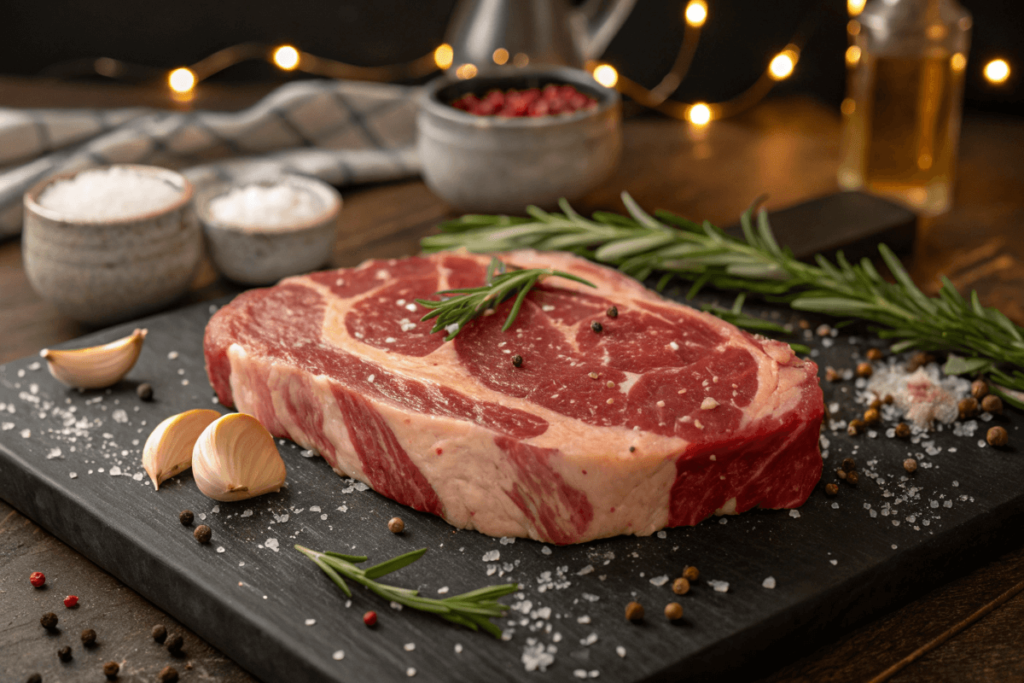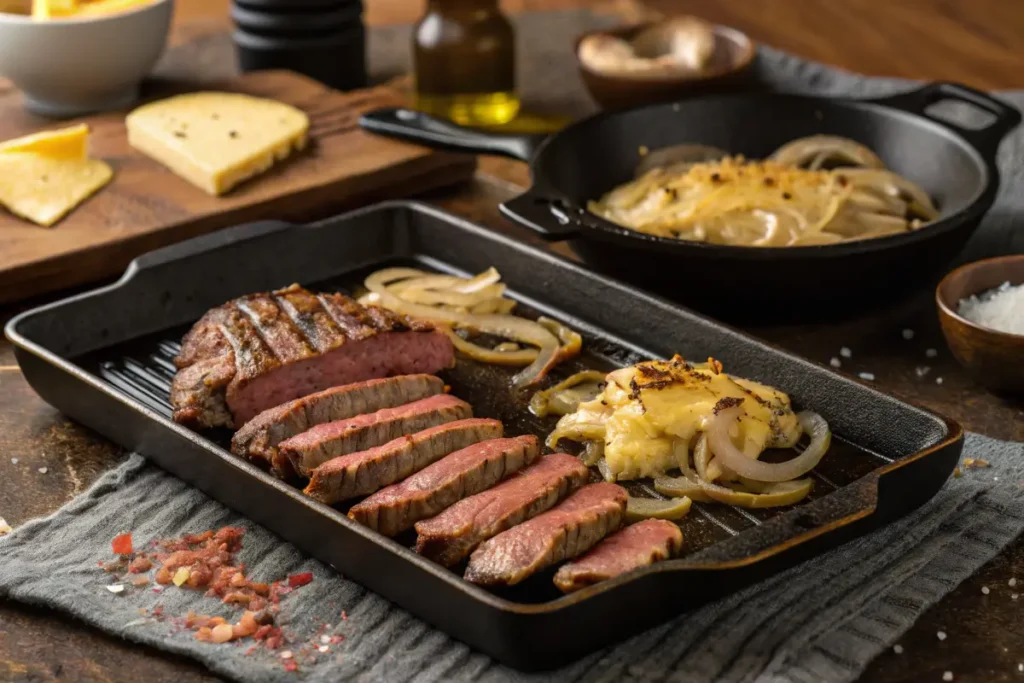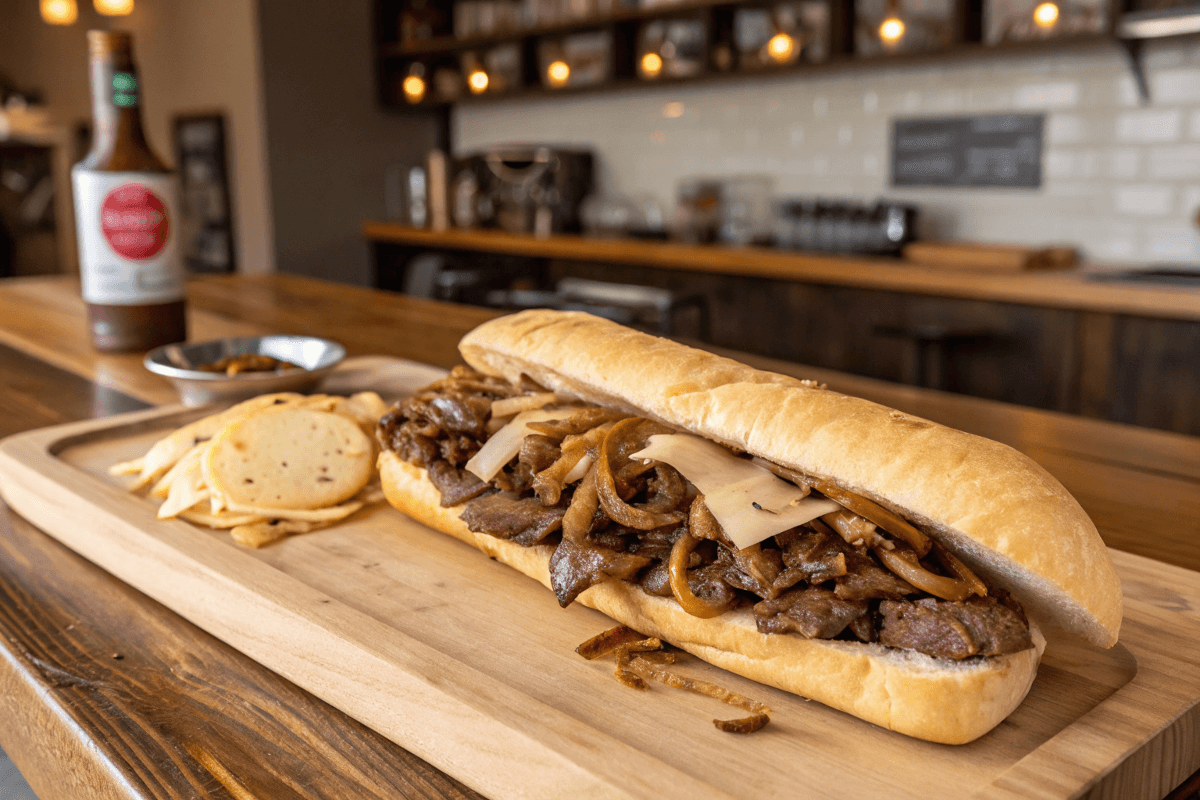Table of Contents
What Cut of Meat Is Good for Philly Cheesesteak?
A Philly cheesesteak isn’t just a sandwich—it’s an experience. But what truly makes it unforgettable? What cut of meat is good for Philly cheesesteak? The answer lies in selecting the perfect steak, cooking it just right, and pairing it with melted cheese and a fresh hoagie roll. Whether you’re a traditionalist or looking for creative alternatives, choosing the right beef is essential. In this guide, we’ll explore the best meat cuts for Philly cheesesteak, the cooking process, and delicious variations to try at home.
Understanding the Origins and Key Features of the Philly Cheesesteak
The History of the Philly Cheesesteak
The Philly cheesesteak dates back to the 1930s when Pat and Harry Olivieri first created the now-iconic sandwich. What started as a simple grilled steak sandwich soon gained popularity, eventually becoming a staple of Philadelphia cuisine. But over the years, one question has remained crucial: What cut of meat is good for Philly cheesesteak?
Traditional Ingredients That Define a Philly Cheesesteak
A classic Philly cheesesteak consists of thinly sliced beef, melted cheese, and a soft hoagie roll. But choosing the right cut of meat makes all the difference. What cut of meat is good for Philly cheesesteak? Ribeye steak is the gold standard due to its rich marbling and tender texture. However, some variations use sirloin, skirt steak, or flank steak for different textures and flavors.
The Importance of Meat Quality in a Cheesesteak
Using high-quality beef ensures the juiciest, most flavorful sandwich. If you’ve ever wondered, What cut of meat is good for Philly cheesesteak? the answer is one that has enough fat content to stay moist while cooking. Ribeye’s marbling makes it the top choice, but leaner cuts like sirloin or flank steak can work when sliced properly and cooked at the right temperature.
The Best Cuts of Meat for Philly Cheesesteak
Top Cuts: Ribeye as the Gold Standard
When it comes to crafting an authentic Philly cheesesteak, ribeye steak stands out as the go-to choice. Why? Ribeye boasts the perfect balance of tenderness, marbling, and rich flavor. This cut ensures that the meat remains juicy and flavorful, even after being cooked on a griddle. The marbling in ribeye melts during cooking, creating that irresistible, melt-in-your-mouth texture that defines the best cheesesteaks. No wonder it’s the preferred option for cheesesteak aficionados.

Other Suitable Cuts: Sirloin, Skirt Steak, and Flank Steak
If ribeye isn’t an option, don’t fret. Other cuts, like sirloin, skirt steak, and flank steak, are worthy contenders. Sirloin offers a leaner alternative while still delivering robust flavor. Skirt steak, known for its distinct grain and tenderness when sliced against the grain, is another excellent choice. Meanwhile, flank steak, though slightly tougher, becomes tender and flavorful when thinly sliced and properly cooked. These options are ideal for home cooks looking for versatile, budget-friendly alternatives.
Factors to Consider: Fat Content, Tenderness, and Flavor
The best cut of meat for a Philly cheesesteak depends on a few key factors. Fat content ensures the meat stays moist and juicy during cooking. Tenderness makes the sandwich easy to bite into, while the overall flavor ties everything together. When selecting a cut, prioritize a balance of these qualities to replicate that iconic Philly taste. For a deeper dive into cooking techniques, check out this guide to making tender leftover steak.
Preparing the Meat for Philly Cheesesteak
How to Slice Steak for Optimal Results
The way you slice the meat can make or break your Philly cheesesteak. Thin slices are non-negotiable. To achieve this, chill the steak in the freezer for about 30 minutes before slicing. A semi-frozen steak is much easier to handle, allowing you to cut it paper-thin. Thin slices ensure that the meat cooks quickly and evenly, creating that characteristic tender texture.
Tips for Freezing and Slicing Meat Thinly
Freezing is a game-changer for preparing cheesesteak meat. After about half an hour in the freezer, use a sharp knife to slice the steak against the grain. Slicing against the grain breaks up the muscle fibers, resulting in tender bites. For added precision, invest in a meat slicer or ask your butcher to handle the slicing for you. Either way, this step is crucial for achieving the perfect consistency.
Marination and Seasoning for Added Flavor
While traditional Philly cheesesteaks don’t rely heavily on marinades, a light seasoning of salt and pepper can enhance the beef’s natural flavor. For a twist, some cooks add garlic powder or Worcestershire sauce to the mix. These subtle additions create depth without overshadowing the beef’s rich, meaty taste. Once seasoned, the meat is ready for the hot griddle.
Alternative Meat Options for Philly Cheesesteak
Using Chicken or Pork: Adjusting the Traditional Recipe
While ribeye steak is the classic choice, there’s room for creativity in your cheesesteak adventure. Swapping beef for chicken or pork offers a delightful twist on tradition. Thinly sliced chicken breast or thigh can bring a lighter flavor profile to the sandwich. Similarly, pork loin or shoulder, when sliced thin and cooked properly, provides a rich and juicy alternative. Both options absorb seasonings beautifully, giving you room to experiment with bold flavors like paprika, garlic, or even a splash of soy sauce.
Plant-Based Alternatives: Replicating the Texture and Flavor
Vegetarians and vegans can still enjoy the Philly cheesesteak experience with plant-based substitutes. Products like seitan or thinly sliced portobello mushrooms mimic the texture of beef, while soy-based meat alternatives offer the juicy, umami flavor you’d expect in the sandwich. Pair these with vegan cheeses and a crusty roll, and you’ve got a delicious plant-based spin on this classic dish.
For more recipe inspiration, consider browsing TesterRecipes’ culinary guides for unique takes on traditional meals.
The Cooking Process: Bringing the Cheesesteak to Life
How to Sear Meat for Maximum Flavor
No matter the meat you choose, searing is a must for locking in flavor. Heat a large griddle or cast-iron skillet until it’s piping hot. Add a drizzle of oil and immediately lay down the thinly sliced meat. Spread the slices out so they cook evenly and develop a beautiful crust. Stir the meat occasionally to prevent overcooking but allow it to sit undisturbed for a minute or two to enhance caramelization.

Incorporating Cheese and Other Ingredients
The cheese is what ties the Philly cheesesteak together. Once your meat is nearly done, top it with your cheese of choice—provolone, Cheez Whiz, or American cheese. Cover the pan briefly to let the cheese melt over the meat. For an authentic touch, sautéed onions are a must. You can also add green peppers or mushrooms, but purists might debate this!
Assembling the Perfect Cheesesteak
The final step is building your sandwich. Split a fresh hoagie roll and layer the cheesy, meaty goodness inside. Make sure the roll is soft yet sturdy enough to hold the juicy filling without falling apart. Serve immediately for the best experience. If you’re hosting a crowd, keep extra rolls and toppings handy to customize each sandwich.
If you’re looking to elevate your sandwich game, try exploring TesterRecipes’ guide on tender steak preparation.
FAQs About Philly Cheesesteak Meat Selection
What Is the Traditional Cut of Meat Used for Philly Cheesesteak?
The traditional cut of meat for Philly cheesesteak is ribeye steak. Known for its rich marbling and tender texture, ribeye provides the perfect balance of flavor and juiciness. Its ability to cook quickly and retain moisture makes it ideal for the thin slicing required in a cheesesteak. While other cuts can work, ribeye remains the gold standard for authenticity.
Can Cheaper Cuts of Meat Work for Cheesesteaks?
Absolutely! Cheaper cuts like skirt steak, flank steak, or even sirloin are viable alternatives. These cuts require extra attention during preparation, such as marinating or slicing against the grain, to ensure tenderness. While they might lack the luxurious fat content of ribeye, proper seasoning and cooking techniques can make them a worthy substitute.
How Do I Achieve the Perfect Balance of Flavor and Texture?
Achieving the perfect Philly cheesesteak relies on combining the right cut of meat with proper preparation. Using high-quality meat, cutting it thin, and cooking it on high heat are essential steps. Additionally, balancing juicy meat with melted cheese and sautéed onions creates a harmonious blend of flavors and textures.
What Are Common Mistakes to Avoid When Choosing Meat?
One common mistake is using overly lean cuts, which can result in a dry and tough sandwich. Another misstep is failing to slice the meat thinly enough, leading to uneven cooking. Lastly, skipping the step of freezing the meat slightly before slicing can make it harder to achieve uniform slices.
Conclusion
The Philly cheesesteak is more than a sandwich; it’s a culinary icon that thrives on the harmony of its key ingredients. Central to its success is the choice of meat, with ribeye steak standing out as the ultimate option. Its marbling, tenderness, and rich flavor set the foundation for the perfect bite.
However, for those seeking alternatives, options like skirt steak, sirloin, or even chicken and plant-based substitutes can provide delightful variations. The secret lies in thinly slicing the meat, seasoning it thoughtfully, and cooking it to perfection. Pair this with melted cheese and a soft hoagie roll, and you’re on your way to Philly cheesesteak greatness.
So, what cut of meat is good for Philly cheesesteak? The answer depends on your taste, budget, and creativity. By understanding the importance of meat quality and preparation, you can craft a cheesesteak that’s both authentic and uniquely yours.
For more culinary inspiration, consider exploring other sandwich ideas or cooking tips. Whether you’re sticking to tradition or trying something new, a perfectly made Philly cheesesteak is always worth the effort!
Exploring Regional and Creative Variations of Philly Cheesesteak
Regional Twists: How Philly Cheesesteak Changes Across Locations
Although the original Philly cheesesteak has a loyal fanbase, regional variations offer exciting twists. In some parts of the U.S., locals add green peppers, mushrooms, or even spicy jalapeños to their cheesesteaks. While traditionalists might frown on these additions, they can add layers of flavor and crunch. Other regions swap out the standard hoagie roll for artisan bread or even ciabatta, offering a fresh take on this classic.
A creative twist that’s gaining traction is the inclusion of unique cheeses. Instead of the usual provolone, Cheez Whiz, or American cheese, some variations use smoked gouda, pepper jack, or even brie. These additions give the cheesesteak a gourmet upgrade.
International Takes: Cheesesteak with a Global Spin
Beyond the U.S., the Philly cheesesteak has inspired adaptations worldwide. In Italy, chefs use thinly sliced prosciutto in place of ribeye, while in Japan, Wagyu beef elevates the dish to luxury status. Middle Eastern variations incorporate shawarma-style meats and tahini-based sauces, blending Philly’s classic sandwich with bold international flavors.
By experimenting with different meats, cheeses, and toppings, food enthusiasts answer the question, “What cut of meat is good for Philly cheesesteak?” in innovative ways. These variations demonstrate how this iconic sandwich can transcend cultures while staying true to its roots.
Pairing Your Cheesesteak with Sides and Beverages
Classic Sides: Perfect Matches for Your Cheesesteak
No cheesesteak is complete without the right sides. French fries, especially those topped with melted cheese or seasoned with Old Bay, are a timeless pairing. Onion rings and coleslaw also complement the cheesesteak’s rich, savory flavors, providing a satisfying crunch and balance.
Potato chips are another convenient choice, offering a lighter, crispy side to balance the cheesesteak’s heartiness. For a healthier option, a simple green salad or roasted vegetables can work wonders while keeping the meal light and fresh.
Beverage Pairings: Drinks That Elevate the Experience
Choosing the right drink can enhance your Philly cheesesteak experience. A cold soda or iced tea is a classic choice, offering a refreshing contrast to the sandwich’s savory, cheesy richness. For beer lovers, a light lager or pale ale pairs beautifully with the cheesesteak’s bold flavors.
Wine enthusiasts can opt for a robust red, like a Zinfandel or Syrah, to complement the richness of the steak. Alternatively, a sparkling water or lemonade can cleanse the palate between bites, ensuring each mouthful is as enjoyable as the first.
For more delicious pairing ideas, check out TesterRecipes’ guides on sides and beverages. Whether you stick to the classics or try something new, the right accompaniments can make your Philly cheesesteak meal unforgettable.

